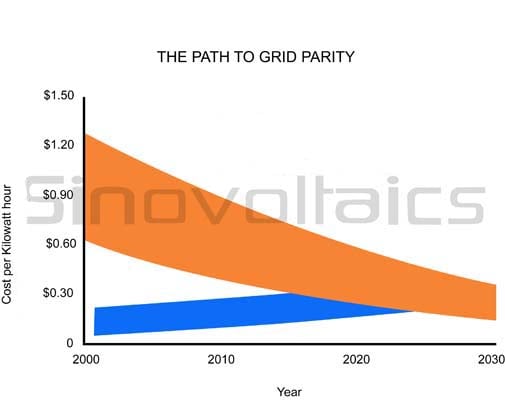Grid Parity: definition of the holy grail in solar energy
Grid parity refers to the point at which solar PV-generated electricity fed to the grid is at least as cheap as electricity from fossil fuels.
What does grid parity mean?
The term grid parity in the solar industry expresses to the point at which solar photovoltaic-generated electricity fed to the power grid is at least as cheap as electricity generated by burning fossil fuel sources. In view of the current trend of decreasing PV module prices, this has been predicted to occur globally in the near future.
Economic difference between gross grid parity and net grid parity
If referring to grid parity in common speech, it usually points to gross grid parity. In the narrow sense, real and thus net grid parityis only reached if solar photovoltaic-generated electricity can replace other sources anytime, which is and can only hardly be the case since PV power is only available when there is sufficient sunlight.
 Grid parity in North America
Grid parity in North AmericaNet grid parity
Actually, net grid parity goes hand in hand with pure off-grid solar conditions, thus a situation in which there is no alternative source of power. This situation requires - according to the average power demand - more PV modules to generate overcapacities of electricity to be stored for non-sunshine situations and consequently additional large battery capacities, eventually also inverters, charge controllers as well as mounting structures. All theses additionally necessary components incur higher costs of the whole PV system. Moreover, due to its complexity, maintenance costs need to be calculated, too. Hence, from the perspective of an end user, net grid parity can only be achieved if the fix costs plus maintenance costs of this whole PV system for a quantity X kWh of produced power during the system's lifetime T amount at least to the total cost of purchasing X kWh over T from a electric power company.
The future with solar energy
Grid parity in the solar industry is considered to be the point when solar panels will seriously start taking market share from fossil fuels, and has the chance to become the dominant form of energy. We can only speak of grid parity when solar energy is generated without subsidies or government support. The exciting thing is that grid parity is a lot closer than most people expect: if the price of solar energy keeps dropping like it did the past 3 years, in many countries grid parity will be reached within now and a decade. Exciting times ahead!

Expert interview with Oliver Kopsch: solar powered water desalination | Aquamark Costa Rica
on 22 Oct 2015Expert interview with Oliver Kopsch: solar powered water desalination | Aquamark Costa Rica Deutsche
on 26 Oct 2015Sherry Rascon
on 27 Oct 2015